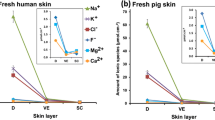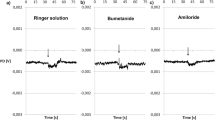Summary
Skins fromRana temporaria, investigated with microelectrode techniques in the absence of Na uptake across the outer border (Na-free epithelial solution or amiloride), were found to be permeable to K+ at the apical membrane in 10–20% of the experiments. Full development of the K+-permeable state requires the absence of Na+ uptake for certain periods of time, which suggests that the K+-permeability of the apical membrane is higher at lower intracellular [Na]. The addition of Ba++ reduces the K+-permeability of the apical membrane. These skins may provide a model for the study of transcellular K+ movements.
Similar content being viewed by others
References
Edmonds, C.J. 1967. Transport of potassium by the colon of normal and sodium-depleted rats.J. Physiol. (London) 193:603
Hermsmeyer, K., Sperelakis, N. 1970. Decrease in K+ conductance and depolarization of frog cardiac muscle produced by Ba++.Am. J. Physiol. 219:1108
Hirschmann, W., Nagel, W. 1978. The outer membrane of frog skin: Impermeable to K+?Pfluegers Arch. 373:R48
Hoshiko, T. 1973. Cation selectivities in frog skin. Alfred Benzon Symposium: Transport Mechanism in Epithelia. pp. 99–114. Munksgaard, Copenhagen
Huf, E.G., Wills, J. 1953. The relationship of sodium uptake, potassium rejection and skin potential in isolated frog skin.J. Gen. Physiol. 36:473
Koefoed-Johnsen, V., Ussing, H.H. 1958. The nature of the frog skin potential.Acta physiol. Scand. 42:298
Levi, H., Ussing, H.H. 1949. Resting potential and ion movements in the frog skin.Nature (London) 164:928
Lindley, B.D., Hoshiko, T. 1964. The effects of alkali metal cations and common anions on the frog skin potential.J. Gen. Physiol. 47:749
Lindley, B.D., Hoshiko, T., Leb, D.E. 1964. Effects of D2O and osmotic gradients on potential and resistance of the isolated frog skin.J. Gen. Physiol. 47:773
Malnic, G., Klose, R.M., Giebisch, G. 1966. Microperfusion study of distal tubular potassium and sodium transfer in rat kidney.Am. J. Physiol. 211:548
Mandel, L.J., Curran, P.F. 1973. Response of the frog skin to steady state voltage clamping. II. The active pathway.J. Gen. Physiol. 62:1
Mullins, L.J. 1959. The penetration of some cations into muscle.J. Gen. Physiol. 42:817
Mullen, T.L., Biber, T.U.L. 1978. Sodium uptake across the outer surface of the frog skin.In: Membrane Transport Processes. Vol. 1. Raven Press, New York
Nagel, W. 1976. The intracellular electrical potential profile of the frog skin epithelium.Pfluegers Arch. 365:135
Nagel, W. 1977. The dependence of the electrical potentials across the membranes of the frog skin upon the concentration of sodium in the mucosal solution.J. Physiol. (London) 269:777
Nagel, W. 1978. Effects of ADH upon electrical potential and resistance of apical and basolateral membranes of frog skin.J. Membrane Biol. 42:99
Nagel, W. 1978. Ba++ decreasesg K in frog skin.Fed. Proc. 37:569
Nagel, W. 1978. Evidence for electrogenic Na transport from the cytoplasmatic tissue pool fo frog skin epithelium.J. Physiol. (London) 285:146P
Nielsen, R. 1971. Effect of amphotericin B on the frog skinin vitro. Evidence for outward active potassium transport across the epithelium.Acta Physiol. Scand. 83:106
Nielsen, R. 1977. Effect of the polyene antibiotic Filipin on the permeability of the inward- and the outward-facing membranes of the isolated frog skin. (R. temp.).Acta Physiol. Scand. 99:399
Pacifio, A.D., Schwartz, M., MacKrell, T.N., Spangler, S.G., Sanders, S.S., Rehm, W.S. 1969. Reversal by potassium of and effect of barium on the frog gastric mucosa.Am. J. Physiol. 216:536
MacRobbie, E.A.C., Ussing, H.H. 1961. Osmotic behaviour of the epithelial cells of frog skin.Acta Physiol. Scand. 53:348
Zeiske, W., Van Driessche, W. 1978. K+-uptake across the outer border of frog skin (R. temp.) and its inhibition by Cs-ions.Pfluegers Arch. 373:R48
Author information
Authors and Affiliations
Rights and permissions
About this article
Cite this article
Nagel, W., Hirschmann, W. K+-permeability of the outer border of the frog skin (R. temporaria). J. Membrain Biol. 52, 107–113 (1980). https://doi.org/10.1007/BF01869115
Issue Date:
DOI: https://doi.org/10.1007/BF01869115




